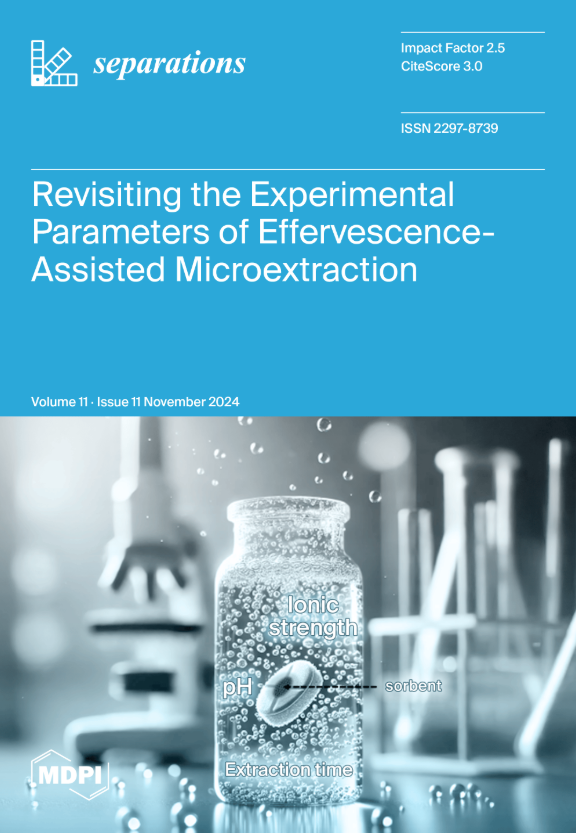Simultaneous Quantification Method of Flavonoids in Jeju Native Citrus from Different Harvest Times Using a High-Performance Liquid Chromatography–Diode Array Detector (HPLC–DAD)
IF 2.7
4区 工程技术
Q3 CHEMISTRY, ANALYTICAL
引用次数: 0
Abstract
In Jeju-native Citrus, flavonoids are the main contributors to the various types of biological activity, such as antioxidant, antitumor, and anti-inflammatory activity. Thus, we developed simultaneous quantification methods for the analysis of ten bioactive flavonoids in Jeju Citrus fruits (Dangyuja, Gamja, Jigak, Sadugam, and Soyuja) harvested at six different time points using a high-performance liquid chromatography–diode array detector (HPLC-DAD). Separation was performed using a flow rate of 0.8 mL/min, a column temperature of 40 °C, a mobile phase buffer of 0.5% acetic acid, and a detection wavelength of 278 nm. The established analytical method showed good linearity (R2 ≥ 0.9997), precision (inter-day < 0.599%, intra-day < 0.055%), and accuracy (recoveries 92.30–108.80%). The HPLC–DAD method was subsequently applied to analyze flavonoids in Citrus samples. Overall, the quantification results indicated that the compositions and content of flavonoids differed for each Citrus species. The harvesting period also influenced the changes in flavonoid content within each Citrus species. The analytical results with chemometrics revealed that higher flavonoid levels in early-harvested Citrus were derived from the improved fruit size and reduced flavonoid synthesis during maturation. This study provides a practical and reliable method for the analysis of ten flavonoids that can be further utilized in the quality assessment of Jeju Citrus.高效液相色谱-二极管阵列检测器(HPLC-DAD)同时定量济州不同采收期柑橘黄酮类化合物
在济州岛原生柑橘中,黄酮类化合物是各种生物活性的主要贡献者,如抗氧化、抗肿瘤和抗炎活性。本研究采用高效液相色谱-二极管阵列检测器(HPLC-DAD)技术,对6个不同时间点收获的济州柑桔(当鱼子、甘子、吉果、沙土柑、黄酮类化合物)中10种生物活性黄酮进行了同时定量分析。分离流速为0.8 mL/min,柱温为40℃,流动相缓冲液为0.5%醋酸,检测波长为278 nm。所建立的分析方法线性良好(R2≥0.9997),精密度(日间&日间;0.599%,日内<0.055%),准确度(回收率92.30 ~ 108.80%)。采用HPLC-DAD法对柑橘样品中的黄酮类化合物进行分析。结果表明,不同柑橘品种黄酮类化合物的组成和含量存在差异。采收期对柑桔类黄酮含量的变化也有影响。化学计量学分析结果表明,早采柑橘果实中黄酮类化合物含量较高是由于成熟过程中果实大小增大和黄酮类化合物合成减少所致。本研究为10种黄酮类化合物的分析提供了一种实用可靠的方法,可进一步用于济州柑橘的品质评价。
本文章由计算机程序翻译,如有差异,请以英文原文为准。
求助全文
约1分钟内获得全文
求助全文
来源期刊

Separations
Chemistry-Analytical Chemistry
CiteScore
3.00
自引率
15.40%
发文量
342
审稿时长
12 weeks
期刊介绍:
Separations (formerly Chromatography, ISSN 2227-9075, CODEN: CHROBV) provides an advanced forum for separation and purification science and technology in all areas of chemical, biological and physical science. It publishes reviews, regular research papers and communications. Our aim is to encourage scientists to publish their experimental and theoretical results in as much detail as possible. There is no restriction on the length of the papers. The full experimental details must be provided so that the results can be reproduced. There are, in addition, unique features of this journal:
Manuscripts regarding research proposals and research ideas will be particularly welcomed.
Electronic files and software regarding the full details of the calculation and experimental procedure, if unable to be published in a normal way, can be deposited as supplementary material.
Manuscripts concerning summaries and surveys on research cooperation and projects (that are funded by national governments) to give information for a broad field of users.
The scope of the journal includes but is not limited to:
Theory and methodology (theory of separation methods, sample preparation, instrumental and column developments, new separation methodologies, etc.)
Equipment and techniques, novel hyphenated analytical solutions (significantly extended by their combination with spectroscopic methods and in particular, mass spectrometry)
Novel analysis approaches and applications to solve analytical challenges which utilize chromatographic separations as a key step in the overall solution
Computational modelling of separations for the purpose of fundamental understanding and/or chromatographic optimization
 求助内容:
求助内容: 应助结果提醒方式:
应助结果提醒方式:


